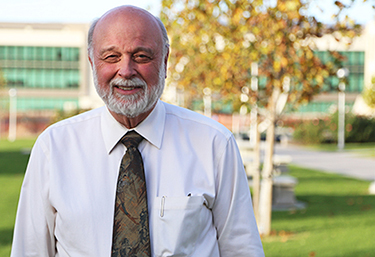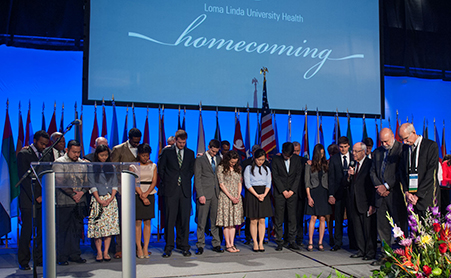 |
| April 2017 |
|
Being distinctive or being inclusive?
Homecoming Weekend was a wonderful few days, with over 2,000 back on campus from years past. For all the things that could have gone wrong, including the weather, it was an amazingly successful time. Many thanks go to Janya Mekelburg and her team from each of the schools who planned carefully for many eventualities. While we learned how to do some things better next year, there was no question that this needs to be an annual event at Loma Linda. There were so many positive comments from those who saw old friends, which would not have happened in the old format. From the Friday night story of our involvement with San Bernardino over 100 years, to Saturday morning at Drayson with music, stories, and Randy Roberts’ inspiring sermon, to the many class and special groups Saturday afternoon and evening, to the Mission Vespers, and finally “Loma Linda’s Got Talent” Saturday night, it was very meaningful to so many. So thanks to the many who came and you all are welcome next year, March 2-5.
I have recently returned from a more sobering meeting with the presidents and senior officers of the 13 colleges and universities owned by the Adventist Church in the U.S. and Canada. These are stalwart institutions, many over 100 years old, with storied pasts and proud cultures. There is great camaraderie among this group, as issues are shared and trends observed. But there are also storm clouds on the horizon, which has already claimed one of our institutions, Atlantic Union College near Boston, and has some threats for all of us. It is partly national demographics, with declining students reaching college age across the country, and partly changing patterns of education, with more online educational options. But for most faith-based institutions, Adventist and others, even stronger concerns are emerging. Both tuition costs and family dynamics are keeping many likely students at home, searching for low-cost community options. And so over the past five years, our collective enrollment in the U.S. Adventist higher education system has dropped about 2 percent a year, from nearly 29,000 in 2012 to 24,369 this year, a loss of over 9 percent. Similar trends are occurring in other private and public educational systems across the country. It is not panic time, but it does require some rethinking of our priorities and strategies.
So once again we spent several days analyzing, talking, and strategizing about what our next steps should be. There is a general sense that we are in this together even though there is certainly some competition among the institutions. Should we merge some campuses, knowing there would be strong local opposition to any talk of that? Do we share courses or limit academic offerings to save faculty costs, or cut extracurricular activities, which is our sweet spot for value added experiences? Through the years we have established task forces to work on options, but have had trouble reaching any consensus. We have also spent hundreds of thousands of marketing dollars annually trying to attract prospective Adventist students from high schools and elsewhere that might be interested in our programs. But still the trends are downward. Many religious educational systems in this country started out rather exclusive, selecting students from their own church. But for most denominations, these boundaries have gradually relaxed over the decades. The Adventist Church has been one of the last to welcome students from other faith persuasions. Now these new pressures are forcing us to ask some fundamental questions – should we share our unique educational environment and philosophy with others who want to learn? The world is searching for authenticity today, for core values that have meaning and provide a foundation for life’s complex issues. We have those. We have a philosophy of education that has stood the test of time, and has demonstrated through the lives of thousands that real meaning in life comes from a healthy lifestyle and commitment to service. Isn’t this what the world is looking for today? But wait a minute you say, I want my kid to be in a protected, somewhat homogenous campus. Cultural diversity is okay, but religious diversity? Will they pick up the “wrong” beliefs, marry someone “outside” the faith, drift from what I have taught them at home? Let me be frank – they are already doing that! Our current techniques are not working very well! Perhaps it is time to be more distinctive while also being more open and inclusive. Perhaps we have come to the world for such a time as this. Instead of being protective, should we be open and sharing? To do this well, we must be comfortable with who we are. We can’t bury our uniqueness, but rather need to feature it. As one of a very few faith-based academic health science centers in the country, Loma Linda has been attractive to students from all faiths for years. They want a spiritual environment, a nurturing presence that openly talks about God and faith, about the role of spirituality in our lives and professions. It is hard to deny them the privilege of being part of our campus and benefiting from this milieu. Does this run some risks? Absolutely! But not doing it runs risks as well. Our experience at Loma Linda has been that these students from other faith traditions make our campus more whole and vibrant as they search out spiritual values and understandings. So my colleagues at many Adventist and other Christian institutions are asking the tough question – has the time come when we should openly invite students of other faiths to join our campuses as we look to share our message and strengthen our academic offerings? Our institutions can each speak for themselves, but the consensus seems to be emerging that this may be our best option, a time for uncovering our light and brightening the world. It will certainly require careful planning to preserve what is core to our campuses, including finding faculty who are comfortable with their beliefs. Can we be inclusive while still being distinctive? Cordially yours,
Richard Hart, MD, DrPH |
April 6, 2017
Notes from the President -- Sharing our values
Share




